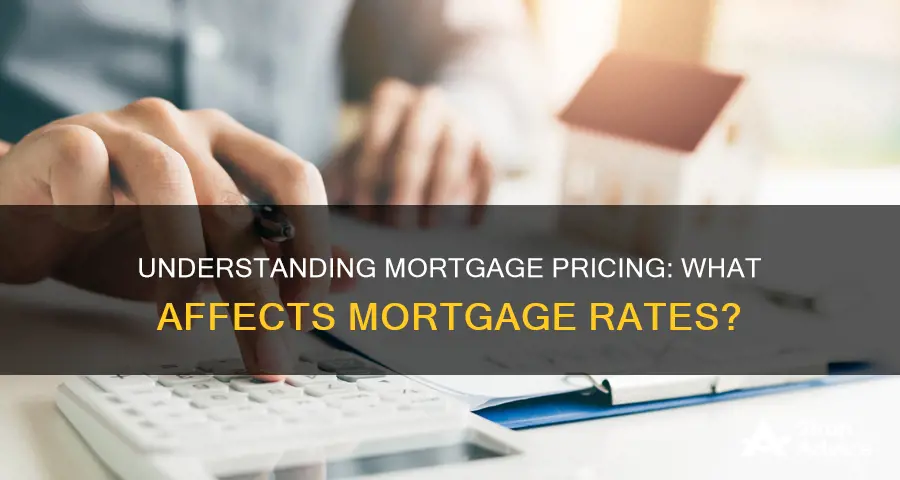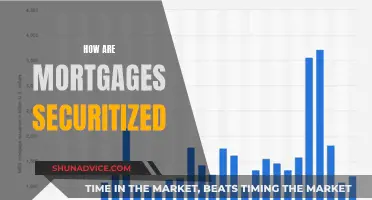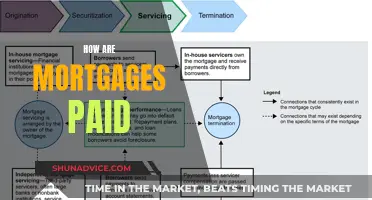
The price of a mortgage is determined by a complex web of factors, including the rate of inflation, the price of US treasuries, the Federal Reserve, and the health of the economy. The type of property, the transaction type, and the number of units are also important factors. Mortgage costs can be divided into two categories: the fees charged by the lender and the costs charged by third parties. The interest rate is the cost of borrowing money and is used to calculate the monthly mortgage payment. The higher the interest rate, the higher the monthly payment. Mortgage interest rates can be fixed, adjustable, or variable.
| Characteristics | Values |
|---|---|
| Mortgage costs | Origination fees, title transfer costs, interest points, and closing costs |
| Interest rates | Fixed, adjustable, or variable |
| Lender | The lender charges fees and third parties charge costs |
| Raw price | The price investors are willing to pay for a loan |
| Basis points | A common unit of measure for interest rates |
| Below par pricing | When an investor is not willing to pay 100% of the loan value |
| Margins | Add-ons to the cost to produce something |
| Corporate margin | The money mortgage companies need to make on loans to pay the bills and turn a profit |
| Pricing engines | Used by mortgage companies to build in margins |
| Owner-occupied residence | Mortgage rates are lower than for an investment property or second home |
| Transaction type | Purchase, rate and term refinance, and cash-out refinance |
| Lock extensions | Small pricing adjustments if you’re unable to close your mortgage on time |
| Down payment | The portion of the home’s price you’re not financing with a mortgage |
| Closing costs | One-time fees associated with getting a mortgage |
| Property taxes | The tax on your home levied by your city or town |
| Mortgage insurance | For conventional or FHA loans, if the down payment is less than 20% of the home's purchase price |
What You'll Learn

Fixed, adjustable, or variable interest rates
The interest rate on a mortgage is like the heartbeat of the loan. It determines how much you will pay over the life of the mortgage, so it is essential to understand the options available.
Fixed-rate mortgages have an interest rate that remains the same throughout the entire loan term. This provides predictability and stability in monthly payments, making budgeting and planning easier. Fixed-rate mortgages are a better choice for long-term homeowners as the interest rate is calculated based on the borrower's financials and set at the beginning of the loan. The longer the mortgage term, the more interest you will pay overall.
Adjustable-rate mortgages (ARMs) have an interest rate that changes at set intervals after a fixed-rate introductory period. The initial interest rate is typically lower than that of a fixed-rate mortgage, but it can increase or decrease in tandem with broader interest rate trends. The rate adjustments are often tied to a stock market or financial index, such as the Secured Overnight Financing Rate (SOFR). ARMs are more complicated than fixed-rate mortgages and may demand bigger down payments and higher incomes from borrowers.
Variable-rate mortgages are similar to ARMs in that the interest rate can change throughout the loan term. The frequency of these changes is determined by the lender and is typically tied to an independent interest rate index, such as the prime rate. Variable-rate mortgages may be well-suited for those who can handle potential payment variations and are able to keep a close eye on market trends to anticipate rate changes.
Closing Costs: Who Pays What in a Mortgage?
You may want to see also

Origination, title transfer, and closing costs
Origination fees are charged by the lender and any mortgage broker for making the mortgage loan. This includes taking and processing the loan application, underwriting and funding the loan, and other administrative services. Origination fees are typically around 1% of the loan amount.
Closing costs are the expenses incurred by both buyers and sellers to finalize a real estate transaction. Closing costs typically range from 2% to 5% of the total loan amount and can include fees for appraisal, title insurance, origination of the loan, and underwriting. Other possible closing costs include escrow deposits, flood determination and monitoring fees, homeowner's insurance, lead-based paint inspection, pest inspection, property tax, recording fees, survey fees, and title search fees. Closing costs must be disclosed to buyers and sellers and agreed upon before a real estate deal can be completed.
Mortgage Prequalification: Is It Reliable?
You may want to see also

How margins are added to raw pricing
The use of margins in the mortgage industry can be quite complex. Margins are add-ons to the cost of producing something. In the context of mortgages, the "raw price" is the price investors are willing to pay for a loan. This is the starting point before any markups or markdowns are made to a company's distribution channels. If a mortgage company wants to make a profit on a loan, they must charge a higher price to the consumer than what the secondary market is willing to pay for that loan, or charge borrowers points to make up the difference. Most borrowers do not want to pay points, so mortgage companies typically raise the interest rate offered.
Mortgage companies have pricing engines that make the process of building in margins simple. These engines are configured by the secondary market teams, which decide on margins and add them to the pricing engine. The team must be careful about how they structure the margins to ensure the company complies with all regulatory guidance regarding pricing. When the pricing engine pulls in the raw pricing for the day, it adds the margins and then displays the rate and price with the margins already built-in.
For an adjustable-rate mortgage, the index is an interest rate that fluctuates periodically based on general market conditions. The margin is a number set by the lender when the borrower applies for the loan. The margin is added to the index rate to set the ARM's interest rate after the initial fixed period, directly influencing the loan's cost over time. The margin provides a stable component to the interest rate calculation, ensuring predictability amidst fluctuating market conditions. The margin is a crucial factor in the cost and structure of adjustable-rate mortgages. Borrowers should carefully consider both the margin and the index when choosing an ARM, as these elements will determine future adjustments to their interest rate and, by extension, their monthly mortgage payments.
The margin size can vary from one lender to another and can be influenced by the borrower's creditworthiness and the specific loan product. It is a critical factor in the overall cost of the loan, making it an important consideration when shopping for a mortgage. Lenders must disclose the margin, along with other critical loan terms, before the borrower agrees to the loan, ensuring transparency in how the adjustable rate is calculated.
Mortgage Advising: After the Loss of a Spouse
You may want to see also

The impact of economic activity on rates
Mortgage rates are influenced by a combination of economic factors and the borrower's financial situation. They are not set by any one entity, but rather, they are influenced by the complex interplay of economic forces.
Economic trends have a direct impact on mortgage rates and the housing market. In a thriving economy with upward trends, mortgage rates tend to rise as lenders and investors seek higher returns on their investments. Conversely, during economic downturns or recessions, mortgage rates generally decrease as lenders aim to stimulate borrowing and support the housing market. For example, during the COVID-19 pandemic, a global economic downturn, mortgage rates dropped to historic lows. As economic activity picked up and employment rates improved, mortgage rates were expected to gradually rise.
The Federal Reserve's monetary policies can also influence mortgage rates. When the Federal Reserve wants to curb inflation or slow down economic growth, it may increase interest rates, making borrowing more expensive and impacting housing affordability. However, their decisions on interest rates do not directly determine mortgage rates but rather influence the overall interest rate environment, which in turn affects the rates offered by lenders.
Inflation is another critical factor that affects mortgage rates. When inflation is high, the purchasing power of a dollar decreases, and lenders compensate by increasing interest rates to maintain their returns. On the other hand, when inflation is low, mortgage rates tend to be more favourable as lenders do not need to adjust rates significantly to protect against inflation.
Additionally, the performance of the housing market is closely tied to economic trends. A strong economy is characterised by low unemployment, increased consumer spending, and rising home prices, while an economic downturn results in higher unemployment, reduced consumer spending, and falling home prices. Interest rates play a crucial role in housing affordability, with low interest rates making homes more accessible and high interest rates doing the opposite.
Mortgage companies also consider their operational costs and profit margins when pricing mortgages. They need to cover overhead expenses, staff salaries, and other costs associated with running the company. These costs are factored into the pricing engines used by mortgage companies to build in margins and determine the final rate offered to borrowers.
Making Mortgage Overpayments: How Does It Work?
You may want to see also

How to read a mortgage rate sheet
Mortgage rate sheets can be confusing for those who are not mortgage professionals. They are packed with endless combinations of numbers, columns, loan programs, and industry jargon. However, understanding mortgage rates and pricing will help you in the long run. Here is a guide on how to read a mortgage rate sheet:
Pricing Adjustments
Mortgage rate sheets include many pricing adjustments that can affect both your mortgage interest rate and closing costs. These adjustments are based on your LTV (loan-to-value) and your unique loan scenario. A pricing hit will raise your interest rate or closing costs, while a pricing incentive will lower your rate or closing costs. The more incentives, the better, as they equate to money back for the borrower.
Loan Programs
Each section of a mortgage rate sheet should be headed with a loan program name and description, such as "30-year fixed, program #sample123". The left-hand side or the top of each rate sheet will show loan programs and rate boxes corresponding to each program.
Interest Rates and Prices
Mortgage rate sheets will show a series of interest rates with corresponding prices across different lock periods. The interest rate is the cost of borrowing money and is used to calculate your monthly mortgage payment. The higher the interest rate, the higher your monthly payment.
Par Rates
Par rates are those closest to 100, meaning little or no cost or credit. If the number is over 100, the excess is provided as a credit to the borrower. If the number is under 100, the borrower must pay discount points (or a fraction thereof) for the given rate.
Raw Price
Raw price is the price that investors are willing to pay for a loan. Investors offer a price along with an associated interest rate. This is the starting point before any mark-ups or mark-downs are made to a company's distribution channels.
Margins
Mortgage companies need to make money on loans to pay the bills and turn a profit. Margins are the add-ons to the cost of producing something. Each part of the supply chain needs to add their profit to the price. Mortgage companies use pricing engines that make the process of building in margins simple.
Transaction Type
The transaction type will also affect your pricing. A purchase will usually result in a rebate or no cost, while a rate and term refinance will generally have no cost, and a cash-out refinance will have an adjustment cost.
Other Pricing Hits
Other factors that can affect your mortgage rate include lock extensions, where you are unable to close your mortgage on time, and the lender won't absorb the cost. The more risk you present to the lender, the more adjustments you'll have, and the more expensive your loan and/or higher your interest rate will be.
Mortgage Estimates: How Accurate Are These Calculations?
You may want to see also
Frequently asked questions
The three types of mortgage rates are fixed, adjustable, and variable. Fixed mortgage rates remain the same throughout the entire loan term, providing predictability and stability in monthly payments. Variable mortgage rates can change throughout the loan term at a frequency determined by the lender. Adjustable rates are similar to variable rates, but the frequency of change is not specified.
Mortgage rates are influenced by economic activity, including jobs reports, the Consumer Price Index (CPI), Gross Domestic Product (GDP), various home sales reports, and Consumer Confidence. A weak economy leads to lower mortgage rates, while a growing economy causes rates to rise. Mortgage rates are also influenced by the rate of inflation, the price of U.S. treasuries, and the Federal Reserve.
Investors influence mortgage rates by deciding how much they are willing to pay to invest in mortgage-backed securities (MBS). If investors perceive a higher risk of default or early repayment, they will demand higher mortgage rates as compensation. The secondary mortgage market also plays a role in determining mortgage rates, as the price at which investors are willing to buy loans from lenders influences the mortgage rate.
Additional costs associated with a mortgage include origination fees, title transfer costs, interest points, and closing costs. Closing costs typically range from 2% to 5% of the mortgage amount and include the lender's origination fee, recording fees, and settlement and title service fees. Other potential costs include mortgage insurance, property taxes, and transaction-specific adjustments, such as lock extensions if you are unable to close the mortgage on time.







